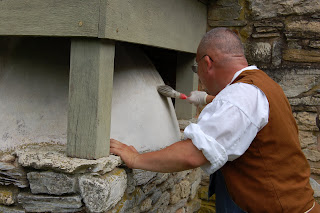

Many thanks to Mary Fenton and George Hetrick for sharing their photos of the event.





Philip Sauerlender (Pennsylvania Military Museum , Boalsburg)
Joseph Palenchar (Railroad Museum of Pennsylvania , Strasburg)
Janet Sherbine (Somerset Historical Center , Somerset)
Charlie Hannon (State Museum of Pennsylvania , Harrisburg)
John G. Maher (Washington Crossing Historic Park , Washington Crossing)
An impressive group, right? Well you can be a part of it, Trailheads. Museums and historic sites are always looking for new volunteers. The United We Serve initiative has a website with opportunities all over the country. But if you’re here in Pennsylvania, any of the sites on the list above would love to hear from you. You never know where it might lead.

The founder of the Ephrata Cloister, Conrad Beissel, was known for instructing chorus members to sing with their heads bowed and mouths almost shut. He was extremely demanding with how the singers performed and even took care of their voices. In fact, Beissel even said that “the angels when they sang at the birth of Christ had to make use of our rules.”
Lots of colonial sites have festivals featuring colonial food, crafts, and activities for children, but few if any have an event that specifically features the colonial building trades and preservation of colonial structures. On June 6th, the Ephrata Cloister featured its 3rd annual Building History: Making and Saving Historic Architecture.
It was a great opportunity to discover the techniques used to build the first homes in the Lancaster area with demonstrations of log hewing, shingle making, wall construction, thatch roofs and early masonry, painting, and window making, to name just a few of the trades that were represented.

The demonstrators were more than happy to share their knowledge. Visitors could take a special walking tour focused on the characteristics of early Pennsylvania German architecture and take advantage of a rare opportunity to tour the unrestored areas of the Ephrata Cloister.

The event also featured lectures by noted local historians. Alan Keyser shared his vast knowledge of Pennsylvania German hearths and heating, and author Cynthia Falk lectured on changes in 18th-century Pennsylvania German architecture.
The highlight for me was a demonstration on colonial pipe drilling. It’s really unbelievable the amount of sweat and labor that went into colonial water systems. You could even participate and give the drill a couple of turns yourself – I gave up after three turns. The whole event was fascinating, fun, and offered something for the whole family.
 Be sure to check out Ephrata's calendar for more events and programs that combine history with food, music, and crafts.
Be sure to check out Ephrata's calendar for more events and programs that combine history with food, music, and crafts.www.flickr.com
|